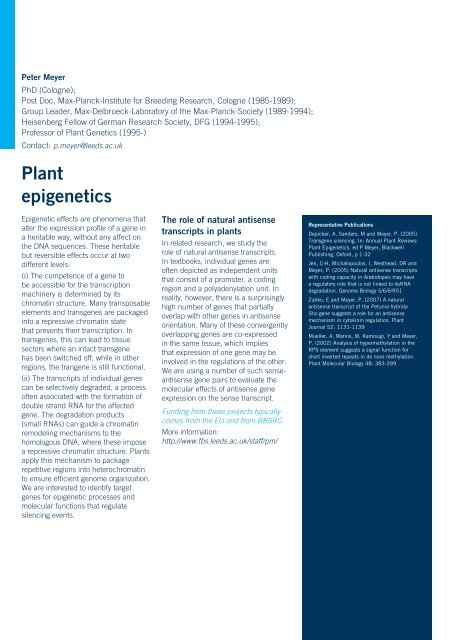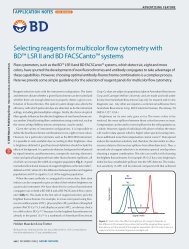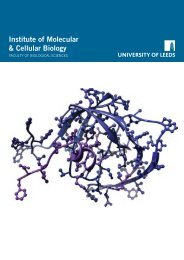3649-08 IICB.indd - Faculty of Biological Sciences - University of ...
3649-08 IICB.indd - Faculty of Biological Sciences - University of ...
3649-08 IICB.indd - Faculty of Biological Sciences - University of ...
You also want an ePaper? Increase the reach of your titles
YUMPU automatically turns print PDFs into web optimized ePapers that Google loves.
Peter Meyer<br />
PhD (Cologne);<br />
Post Doc, Max-Planck-Institute for Breeding Research, Cologne (1985-1989);<br />
Group Leader, Max-Delbrueck-Laboratory <strong>of</strong> the Max-Planck-Society (1989-1994);<br />
Heisenberg Fellow <strong>of</strong> German Research Society, DFG (1994-1995);<br />
Pr<strong>of</strong>essor <strong>of</strong> Plant Genetics (1995-)<br />
Contact: p.meyer@leeds.ac.uk<br />
Plant<br />
epigenetics<br />
Epigenetic effects are phenomena that<br />
alter the expression pr<strong>of</strong>ile <strong>of</strong> a gene in<br />
a heritable way, without any affect on<br />
the DNA sequences. These heritable<br />
but reversible effects occur at two<br />
different levels:<br />
(i) The competence <strong>of</strong> a gene to<br />
be accessible for the transcription<br />
machinery is determined by its<br />
chromatin structure. Many transposable<br />
elements and transgenes are packaged<br />
into a repressive chromatin state<br />
that prevents their transcription. In<br />
transgenes, this can lead to tissue<br />
sectors where an intact transgene<br />
has been switched <strong>of</strong>f, while in other<br />
regions, the trangene is still functional.<br />
(ii) The transcripts <strong>of</strong> individual genes<br />
can be selectively degraded, a process<br />
<strong>of</strong>ten associated with the formation <strong>of</strong><br />
double strand RNA for the affected<br />
gene. The degradation products<br />
(small RNAs) can guide a chromatin<br />
remodeling mechanisms to the<br />
homologous DNA, where these impose<br />
a repressive chromatin structure. Plants<br />
apply this mechanism to package<br />
repetitive regions into heterochromatin<br />
to ensure efficient genome organization.<br />
We are interested to identify target<br />
genes for epigenetic processes and<br />
molecular functions that regulate<br />
silencing events.<br />
The role <strong>of</strong> natural antisense<br />
transcripts in plants<br />
In related research, we study the<br />
role <strong>of</strong> natural antisense transcripts.<br />
In textbooks, individual genes are<br />
<strong>of</strong>ten depicted as independent units<br />
that consist <strong>of</strong> a promoter, a coding<br />
region and a polyadenylation unit. In<br />
reality, however, there is a surprisingly<br />
high number <strong>of</strong> genes that partially<br />
overlap with other genes in antisense<br />
orientation. Many <strong>of</strong> these convergently<br />
overlapping genes are co-expressed<br />
in the same tissue, which implies<br />
that expression <strong>of</strong> one gene may be<br />
involved in the regulations <strong>of</strong> the other.<br />
We are using a number <strong>of</strong> such senseantisense<br />
gene pairs to evaluate the<br />
molecular effects <strong>of</strong> antisense gene<br />
expression on the sense transcript.<br />
Funding from these projects typically<br />
comes from the EU and from BBSRC.<br />
More information:<br />
http://www.fbs.leeds.ac.uk/staff/pm/<br />
Representative Publications<br />
Depicker, A, Sanders, M and Meyer, P. (2005)<br />
Transgene silencing. In: Annual Plant Reviews:<br />
Plant Epigenetics, ed P Meyer, Blackwell<br />
Publishing, Oxford, p 1-32<br />
Jen, C-H, Michalopoulos, I, Westhead, DR and<br />
Meyer, P. (2005) Natural antisense transcripts<br />
with coding capacity in Arabidopsis may have<br />
a regulatory role that is not linked to dsRNA<br />
degradation. Genome Biology 5/6/6/R51<br />
Zubko, E and Meyer, P. (2007) A natural<br />
antisense transcript <strong>of</strong> the Petunia hybrida<br />
Sho gene suggests a role for an antisense<br />
mechanism in cytokinin regulation. Plant<br />
Journal 52: 1131-1139<br />
Mueller, A, Marins, M, Kamisugi, Y and Meyer,<br />
P. (2002) Analysis <strong>of</strong> hypermethylation in the<br />
RPS element suggests a signal function for<br />
short inverted repeats in de novo methylation.<br />
Plant Molecular Biology 48: 383-399










